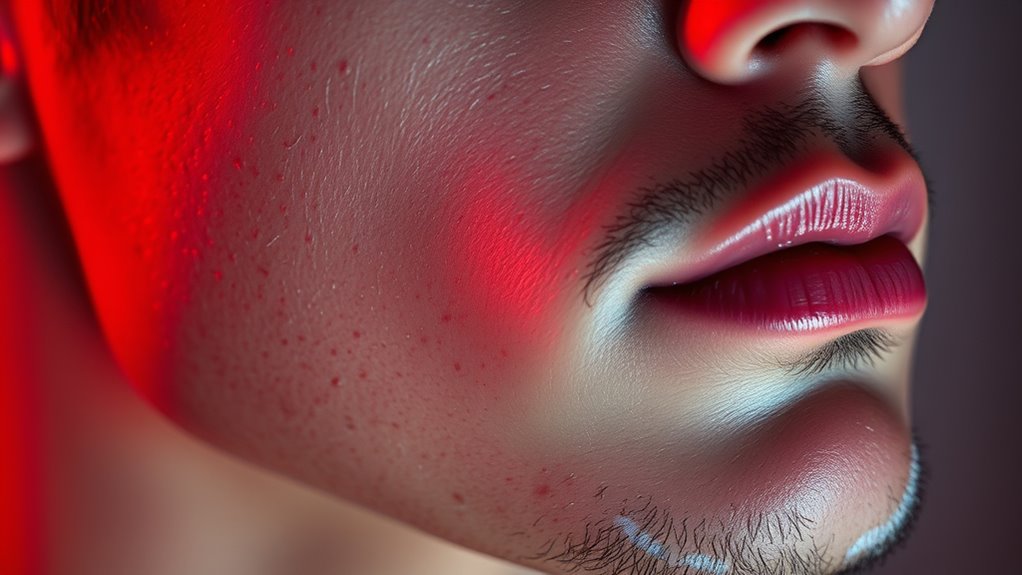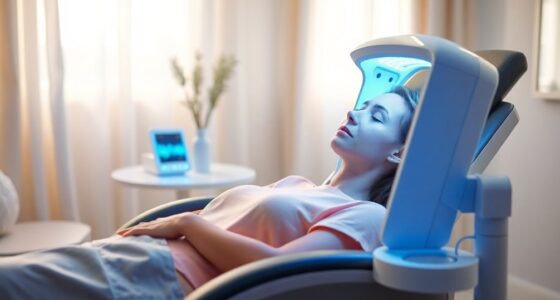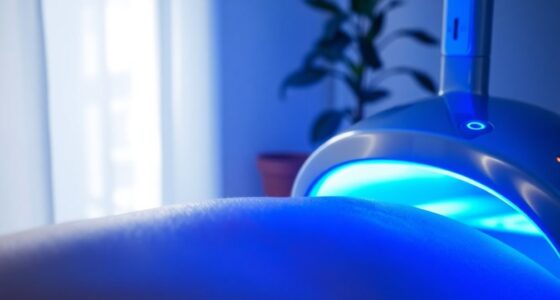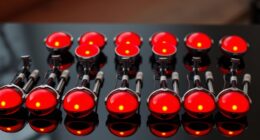After shaving, red light therapy can help reduce razor burn by calming skin irritation and speeding up healing. Use a device with wavelengths around 630 to 670 nanometers, holding it a few inches from the affected area for 5-10 minutes. Consistent use can lower redness and bumps, leaving your skin calmer and smoother. Keep in mind that proper technique and skincare routines enhance results—continue exploring how this simple treatment can improve your post-shave skin.
Key Takeaways
- Use red light therapy devices on shaved skin for 5-10 minutes to reduce inflammation and promote healing.
- Consistently apply red light after shaving to minimize redness, bumps, and irritation.
- Ensure the device emits wavelengths around 630-670 nm for effective skin healing.
- Combine red light therapy with gentle moisturizers or soothing ointments for better comfort.
- Follow safety guidelines, avoid eye exposure, and incorporate therapy into your post-shaving routine for optimal results.
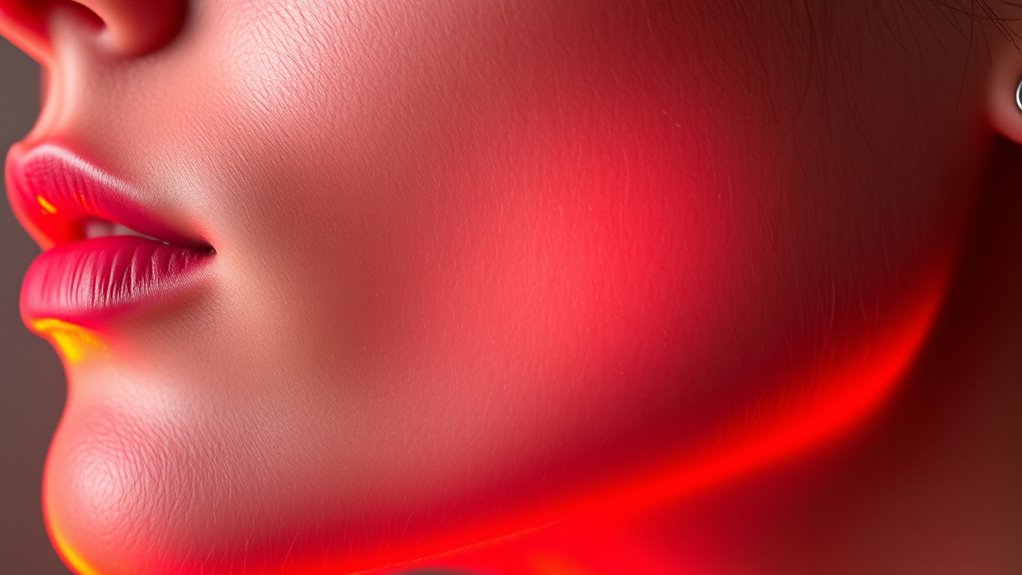
After shaving, many people notice redness and irritation on their skin, which can be uncomfortable and unsightly. Razor burn is a common issue caused by skin irritation from the shaving process, often resulting in redness, bumps, and sometimes itching. While there are many remedies to soothe razor burn, one emerging treatment that’s gaining popularity is red light therapy. This non-invasive technique uses specific wavelengths of red light to promote healing and reduce inflammation. If you’re tired of dealing with persistent irritation after shaving, understanding how red light can help might be worth considering. Red light therapy works by penetrating the skin layers and stimulating cellular activity. When you apply red light to irritated skin, it boosts blood circulation and encourages the production of collagen, which helps repair damaged tissue. The increased blood flow delivers oxygen and nutrients more efficiently to the affected area, accelerating healing. Additionally, red light reduces the production of pro-inflammatory cytokines, which are responsible for inflammation and redness. As a result, your skin can recover faster, with less swelling and discomfort. This process is safe, painless, and doesn’t require any downtime, making it an attractive option for those seeking quick relief. Incorporating red light therapy into your skincare routine can enhance overall skin health and potentially prevent future irritation. Using red light therapy after shaving is straightforward. You can find handheld devices or professional treatment sessions at clinics. If you opt for a device, make sure it emits the correct wavelength—typically around 630 to 670 nanometers—for ideal results. To use it, simply hold the device a few inches from your skin and expose the irritated area for about 5 to 10 minutes. Consistency is key; applying red light therapy regularly, especially right after shaving, can markedly reduce the severity and duration of razor burn. Many users report noticing improvements within a few sessions, with skin appearing calmer, less red, and more comfortable. While red light therapy is generally safe, it’s important to follow the manufacturer’s instructions carefully. Avoid shining the light directly into your eyes, and if you have skin conditions or are sensitive to light, consult a healthcare professional before starting treatment. Keep in mind that red light isn’t a cure-all, but it can be a valuable addition to your post-shaving routine. Combining it with gentle skincare, such as soothing ointments or moisturizers, can further enhance your skin’s recovery. Over time, regular red light treatments may help prevent future irritation, leaving your skin smoother, healthier, and less prone to razor burn.
Frequently Asked Questions
Can Red Light Therapy Prevent Ingrown Hairs After Shaving?
Yes, red light therapy can help prevent ingrown hairs after shaving. It works by reducing inflammation and promoting healthy skin healing, which lessens the chances of hairs growing back into the skin. When you use red light therapy regularly, it can soothe irritated skin and improve circulation, making it easier for hairs to grow out properly. Incorporate it into your post-shaving routine for better skin health and fewer ingrown hairs.
How Often Should I Use Red Light Therapy Post-Shaving?
Think of red light therapy as a gentle breeze soothing your skin. You should use it 3-4 times a week after shaving to reduce irritation and promote healing. Consistency is key; each session helps calm redness and supports skin recovery. Don’t overdo it—allow your skin time to breathe between treatments. With regular use, you’ll notice smoother, calmer skin, making shaving less of a chore and more of a comfort.
Does Red Light Therapy Work on Sensitive Skin?
Yes, red light therapy can work on sensitive skin. It helps reduce inflammation and soothe irritation, making your skin feel calmer after shaving. When you use it, start with a gentle setting and keep sessions brief to avoid overstimulation. Consistent use over time can improve your skin’s resilience, diminish redness, and promote healing. Just be sure to patch-test first and follow device instructions carefully to prevent any adverse reactions.
Are There Any Side Effects of Red Light Treatment After Shaving?
Think of red light therapy as a gentle rain soothing your skin after shaving—it’s generally safe, but you might experience slight redness or irritation if your skin is very sensitive. Some people notice temporary dryness or a tingling sensation. Always follow proper guidelines, avoid overexposure, and do a patch test first. If you see persistent discomfort, it’s best to consult a dermatologist.
Can Red Light Therapy Replace Traditional Aftershave Products?
Red light therapy can supplement traditional aftershave products, but it shouldn’t fully replace them. You benefit from its soothing, anti-inflammatory effects that help reduce razor burn and irritation. However, aftershaves offer additional benefits like antibacterial properties and fragrance, which red light therapy doesn’t provide. For best results, incorporate both into your post-shaving routine, ensuring your skin stays calm, clean, and refreshed.
Conclusion
If you’re worried that red light therapy might be complicated or costly, think again. It’s an easy, affordable way to soothe razor burn and prevent irritation, giving you smoother skin and more confidence. Don’t let fear hold you back from trying something that could truly transform your shaving routine. With just a few minutes of red light after shaving, you can say goodbye to redness and hello to calmer, healthier skin. Give it a shot—you deserve it.
